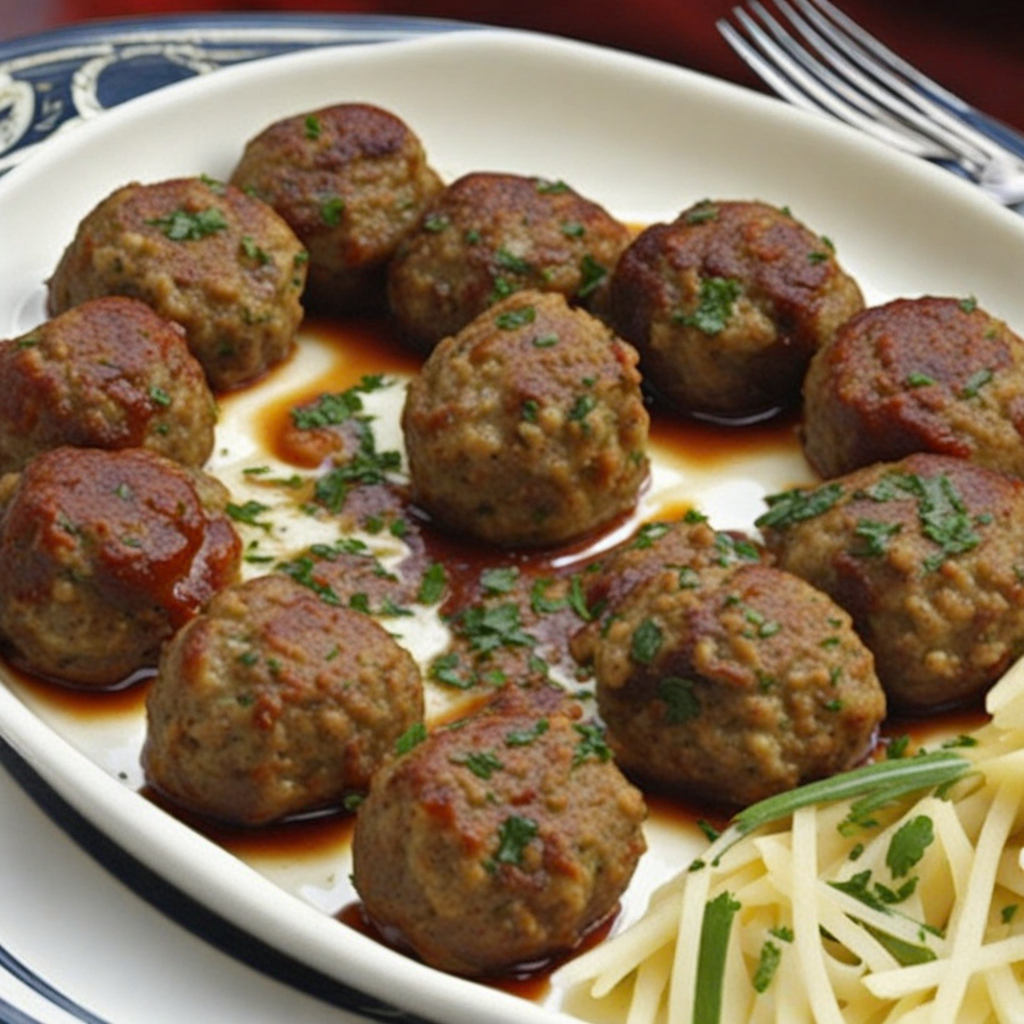Keftedes
Keftedes are a delightful traditional dish hailing from Cyprus, known for their rich flavors and satisfying texture. These aromatic meatballs are typically made from a blend of ground lamb or beef, mixed with finely chopped onions, garlic, and a variety of herbs such as parsley and mint. The addition of spices like cumin and coriander enhances their flavor profile, while breadcrumbs or rice are often incorporated to bind the mixture and add a tender, moist quality. Each bite reveals a harmonious balance of savory meatiness and fragrant herbs, making Keftedes a truly tantalizing experience for the palate. The cooking method further elevates the dish; Keftedes are usually pan-fried to achieve a golden-brown crust, which adds a delightful crunch that contrasts beautifully with the tender insides. Some variations of Keftedes can also be found baked or grilled, which impart a smoky flavor that complements the spices. Served hot, these meatballs are often accompanied by a side of fresh tzatziki sauce, a cool and creamy yogurt dip made with cucumber and garlic, which cuts through the richness and adds a refreshing element to the meal. In Cyprus, Keftedes are typically enjoyed as part of a meze platter, allowing diners to savor a variety of dishes in one sitting. This communal style of dining encourages exploration and experimentation with flavors, making Keftedes a perfect introduction to the vibrant culinary culture of the island. The dish embodies the warmth and hospitality of Cypriot cuisine, inviting anyone eager to discover a new taste to indulge in this delightful and satisfying treat.
How It Became This Dish
The Delicious Journey of Κεφτέδες: A Culinary Gem from Cyprus #### Introduction In the heart of the Mediterranean lies Cyprus, a land rich in history, culture, and, of course, food. Among the myriad dishes that define Cypriot culinary heritage, Κεφτέδες (keftedes) holds a special place. These delectable meatballs, often spiced to perfection, are not merely a dish; they embody the island's vibrant history, cultural significance, and delightful evolution over time. #### Origins: A Mediterranean Influence The roots of Κεφτέδες can be traced back to the ancient civilizations that flourished around the Mediterranean basin. The term "keftedes" is derived from the Arabic word "kefṭ," which means to grind or mince. The influence of Arabic cuisine is evident in many aspects of Cypriot food culture. The island's strategic location has historically made it a crossroads of various civilizations, including the Greeks, Romans, Byzantines, Ottomans, and the British, each leaving their culinary mark. The concept of minced meat formed into balls is not unique to Cyprus; variations exist throughout the Mediterranean and the Middle East. In Greece, for instance, similar meatballs known as "keftedes" are popular, often flavored with herbs like mint and served with a tangy tomato sauce. From Turkey's köfte to Levantine kibbeh, the basic principles of forming ground meat into shapes and flavoring it with spices have been woven into the fabric of many cultures. #### Cultural Significance In Cyprus, Κεφτέδες are more than just a dish; they are a symbol of communal dining and hospitality. Traditionally served as part of a meze—a collection of small dishes meant for sharing—these meatballs invite togetherness and celebration. They are often enjoyed in family gatherings, festive occasions, and casual meals, echoing the island's ethos of community and connection. The preparation of Κεφτέδες often involves family recipes passed down through generations. Each family may have its unique twist, incorporating various spices, herbs, and even vegetables. The process becomes a bonding experience, as family members gather in the kitchen to create these culinary delights. Often paired with a side of tzatziki or tahini sauce, the enjoyment of Κεφτέδες transcends mere nourishment; it becomes a shared ritual that fosters relationships. #### Development Over Time As Cyprus evolved through various historical phases, so too did its food culture. The Ottoman rule, which began in the late 16th century and lasted until the British invasion in 1878, significantly influenced Cypriot cuisine, including the preparation of Κεφτέδες. Under Ottoman influence, the use of spices became more pronounced, with cumin, coriander, and allspice becoming staples in many dishes. The Cypriot version of Κεφτέδες often includes these spices, lending a unique flavor profile that sets it apart from its Greek or Turkish counterparts. The British colonial period brought further changes, introducing new ingredients and culinary techniques. During this era, the local palate began to incorporate more diverse flavors, including the use of breadcrumbs or rice in the meatball mixture. As Cypriots adapted to these new influences, Κεφτέδες became a versatile dish, with variations reflecting both traditional and modern tastes. In the late 20th century, as globalization took hold, Cypriot cuisine began to gain international recognition. Chefs and home cooks alike started experimenting with traditional recipes, incorporating local ingredients such as halloumi cheese or fresh herbs from the island’s rich landscapes. The rise of the Mediterranean diet in the 1990s, celebrated for its health benefits, also played a role in popularizing dishes like Κεφτέδες, showcasing their role in a balanced diet. #### Modern-Day Keftedes: A Culinary Renaissance Today, Κεφτέδες continue to be a beloved staple in Cypriot households and restaurants. They are often featured in local taverns, where chefs embrace both tradition and innovation. The modern interpretation of Κεφτέδες may involve variations such as vegetarian options made from lentils or chickpeas, reflecting the increasing demand for plant-based diets. Food festivals across Cyprus celebrate the island's culinary heritage, with Κεφτέδες often taking center stage. Events like the "Flavors of Cyprus" festival not only highlight traditional recipes but also encourage chefs to showcase their creativity while respecting their roots. This blending of old and new ensures that Κεφτέδες remain relevant in today's culinary landscape. Moreover, the rise of social media has enabled the sharing of traditional recipes and cooking techniques, allowing a younger generation to connect with their heritage. Through platforms like Instagram and TikTok, home cooks and professional chefs alike showcase their take on Κεφτέδες, inspiring others to experiment with flavors and presentation. #### Conclusion Κεφτέδες are much more than just meatballs; they are a reflection of Cypriot identity, history, and culture. As they have traveled through time, influenced by various civilizations, they have maintained their status as a beloved dish on the island. The journey of Κεφτέδες—from their ancient origins to their modern interpretations—mirrors Cyprus's rich tapestry of cultural influences and communal spirit. In a world increasingly focused on individualism, the act of sharing a plate of Κεφτέδες encapsulates the essence of togetherness. Whether enjoyed at a family gathering, a festive occasion, or a cozy meal, these flavorful meatballs continue to bring people together, creating cherished memories that are as enduring as the dish itself. As Cyprus moves forward, Κεφτέδες will undoubtedly remain a cherished culinary treasure, lovingly prepared and shared across generations.
You may like
Discover local flavors from Cyprus







